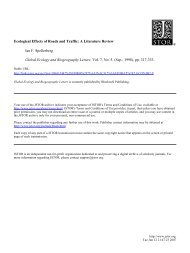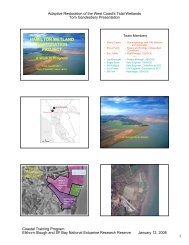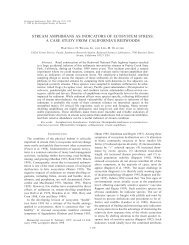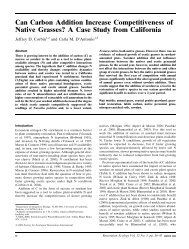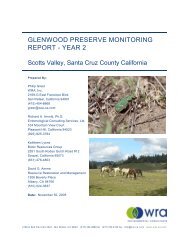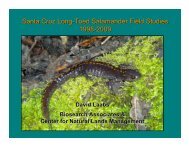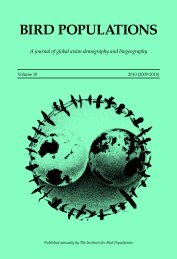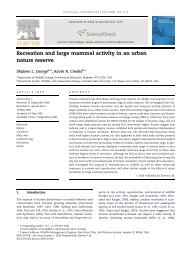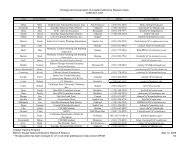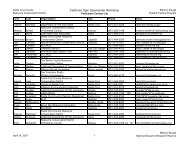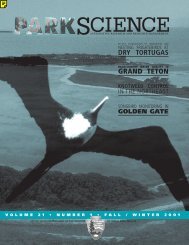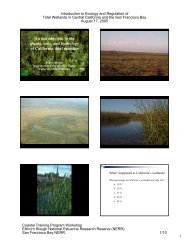California Tiger Salamander Bibliography - the Elkhorn Slough ...
California Tiger Salamander Bibliography - the Elkhorn Slough ...
California Tiger Salamander Bibliography - the Elkhorn Slough ...
Create successful ePaper yourself
Turn your PDF publications into a flip-book with our unique Google optimized e-Paper software.
californiense) breeding pool. In R. E. Jung & J.C. Mitchell (Eds.), Urban Herpetology,<br />
Herpetological Conservation, Vol. 3, Society for <strong>the</strong> Study of Amphibians and Reptiles,<br />
Salt Lake City, UT, USA.<br />
At a breeding pond in Santa Rosa most adults were captured entering on <strong>the</strong> east side of<br />
<strong>the</strong> pond. This appears to be because substantial grassland habitat only remains in this<br />
direction. Captures did not appear to be related to <strong>the</strong> amount of grassland within 100 m<br />
of <strong>the</strong> pool but to <strong>the</strong> amounts far<strong>the</strong>r away (200 – 700 m).<br />
Trenham, P.C., W.D. Koenig, and H.B. Shaffer. 2001. Spatially autocorrelated<br />
demography and interpond dispersal in <strong>the</strong> <strong>California</strong> tiger salamander, Ambystoma<br />
californiense. Ecology 82: 3519-3530.<br />
Animals marked at 10 different breeding ponds along a 3km transect were recaptured<br />
over a period of three years. Roughly 25% of recaptured CTS were at a pond o<strong>the</strong>r than<br />
<strong>the</strong> one where <strong>the</strong>y were originally marked. Individuals moved between ponds separated<br />
by up to 680 meters. This reflects more interpond dispersal than would have been<br />
expected previously.<br />
Trenham, P.C. and H.B. Shaffer. 2005. Amphibian upland habitat use and its<br />
consequences for population viability. Ecological Applications 15:158-1168.<br />
Single season study of CTS densities in upland habitat around Olcott Lake, Solano<br />
County. Capture rates of adults was highest in traps 10 m from <strong>the</strong> pond and declined in<br />
traps far<strong>the</strong>r out; subadult capture rates during <strong>the</strong> winter months were lowest at 10 m<br />
from <strong>the</strong> pond and peaked in traps 400 m out. Estimated that 95% of both subadults and<br />
adults remain within 630 m of this breeding pond, and that ponds with 600 m of intact<br />
upland habitat surrounding <strong>the</strong>m will support populations near <strong>the</strong>ir natural capacity.<br />
Trenham, P.C., H.B. Shaffer, W.D. Koenig, and M.R. Stromberg. 2000. Life history<br />
and demographic variation in <strong>the</strong> <strong>California</strong> tiger salamander (Ambystoma californiense).<br />
Copeia 2000:365-377.<br />
Seven year study of CTS in one ephemeral constructed livestock pond in Monterey<br />
County. Showed that



